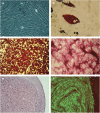The potential use of stem cells derived from human amniotic fluid in renal diseases
- PMID: 25028628
- PMCID: PMC4089735
- DOI: 10.1038/kisup.2011.18
The potential use of stem cells derived from human amniotic fluid in renal diseases
Abstract
Amniotic fluid (AF) contains a variety of cell types derived from fetal tissues that can easily grow in culture. These cells can be obtained during amniocentesis for prenatal screening of fetal genetic diseases, usually performed during the second trimester of pregnancy. Of particular interest, some expanded sub-populations derived from AF cells are capable of extensive self-renewal and maintain prolonged undifferentiated proliferation, which are defining properties of stem cells. These human AF stem cells (hAFSCs) exhibit multilineage potential and can differentiate into the three germ layers. They have high proliferation rates and express mesenchymal and embryonic markers, but do not induce tumor formation. In this study, hAFSCs derived from amniocentesis performed at 16-20 weeks of pregnancy were isolated, grown in culture, and characterized by flow cytometry and by their potential ability to differentiate into osteogenic, adipogenic, and chondrogenic lineages. After 4-7 passages, 5 × 105 hAFSCs were inoculated under the kidney capsule of Wistar rats that were subjected to an experimental model of chronic renal disease, the 5/6 nephrectomy model (Nx). After 30 days, Nx rats treated with hAFSCs displayed significant reductions in blood pressure, proteinuria, macrophages, and α-smooth muscle actin expression compared with Nx animals. These preliminary results suggest that hAFSCs isolated and expanded from AF obtained by routine amniocentesis can promote renoprotection in the Nx model. Considering that the AF cells not used for fetal karyotyping are usually discarded, and that their use does not raise ethical issues, they may represent an alternative source of stem cells for cell therapy and regenerative medicine.
Keywords: amniotic fluid stem cells; chronic kidney disease; mesenchymal stem cells.
Figures


Similar articles
-
Molecular and proteomic characterization of human mesenchymal stem cells derived from amniotic fluid: comparison to bone marrow mesenchymal stem cells.Stem Cells Dev. 2007 Dec;16(6):931-52. doi: 10.1089/scd.2007.0036. Stem Cells Dev. 2007. PMID: 18047393
-
Human amniotic fluid stem cells (hAFSCs) expressing p21 and cyclin D1 genes retain excellent viability after freezing with (dimethyl sulfoxide) DMSO.Bosn J Basic Med Sci. 2019 Feb 12;19(1):43-51. doi: 10.17305/bjbms.2018.2912. Bosn J Basic Med Sci. 2019. PMID: 29688163 Free PMC article.
-
Amniotic Fluid Derived Stem Cells with a Renal Progenitor Phenotype Inhibit Interstitial Fibrosis in Renal Ischemia and Reperfusion Injury in Rats.PLoS One. 2015 Aug 21;10(8):e0136145. doi: 10.1371/journal.pone.0136145. eCollection 2015. PLoS One. 2015. PMID: 26295710 Free PMC article.
-
Amniotic fluid stem cells as a novel strategy for the treatment of fetal and neonatal neurological diseases.Placenta. 2021 Jan 15;104:247-252. doi: 10.1016/j.placenta.2021.01.009. Epub 2021 Jan 12. Placenta. 2021. PMID: 33461069 Review.
-
Highly potent stem cells from full-term amniotic fluid: A realistic perspective.Reprod Biol. 2017 Mar;17(1):9-18. doi: 10.1016/j.repbio.2017.02.001. Epub 2017 Mar 3. Reprod Biol. 2017. PMID: 28262444 Review.
Cited by
-
Reno-protection of Urine-derived Stem Cells in A Chronic Kidney Disease Rat Model Induced by Renal Ischemia and Nephrotoxicity.Int J Biol Sci. 2020 Jan 1;16(3):435-446. doi: 10.7150/ijbs.37550. eCollection 2020. Int J Biol Sci. 2020. PMID: 32015680 Free PMC article.
-
Expression of ABCB1, ABCC1, and LRP in Mesenchymal Stem Cells from Human Amniotic Fluid and Bone Marrow in Culture-Effects of In Vitro Osteogenic and Adipogenic Differentiation.Int J Mol Sci. 2025 Jan 9;26(2):510. doi: 10.3390/ijms26020510. Int J Mol Sci. 2025. PMID: 39859227 Free PMC article.
-
Enhanced efficiency in isolation and expansion of hAMSCs via dual enzyme digestion and micro-carrier.Cell Biosci. 2020 Jan 6;10:2. doi: 10.1186/s13578-019-0367-y. eCollection 2020. Cell Biosci. 2020. PMID: 31921407 Free PMC article.
-
Stem cell-derived exosomes: emerging therapeutic opportunities for wound healing.Stem Cell Res Ther. 2023 Apr 26;14(1):107. doi: 10.1186/s13287-023-03345-0. Stem Cell Res Ther. 2023. PMID: 37101197 Free PMC article. Review.
-
Tissue-Engineering Approaches to Restore Kidney Function.Curr Diab Rep. 2015 Oct;15(10):69. doi: 10.1007/s11892-015-0643-0. Curr Diab Rep. 2015. PMID: 26275443 Review.
References
-
- Kern S, Eichler H, Stoeve J, et al. Comparative analysis of mesenchymal stem cells from bone marrow, umbilical cord blood, or adipose tissue. Stem Cells. 2006;24:1294–1301. - PubMed
-
- Priest RE, Marimuthu KM, Priest JH. Origin of cells in human amniotic fluid cultures: ultrastructural features. Lab Invest. 1978;39:106–109. - PubMed
-
- Gosden CM. Amniotic fluid cell types and culture. Br Med Bull. 1983;39:348–354. - PubMed
-
- In't Anker PS, Scherjon SA, Kleijburg-van der KC, et al. Amniotic fluid as a novel source of mesenchymal stem cells for therapeutic transplantation. Blood. 2003;102:1548–1549. - PubMed
-
- Hoehn H, Salk D. Morphological and biochemical heterogeneity of amniotic fluid cells in culture. Methods Cell Biol. 1982;26:11–34. - PubMed
Publication types
LinkOut - more resources
Full Text Sources

